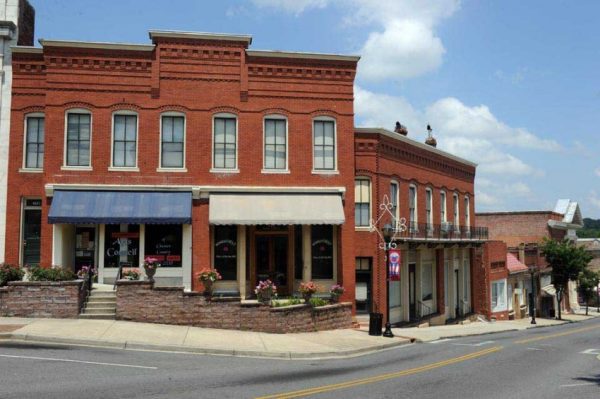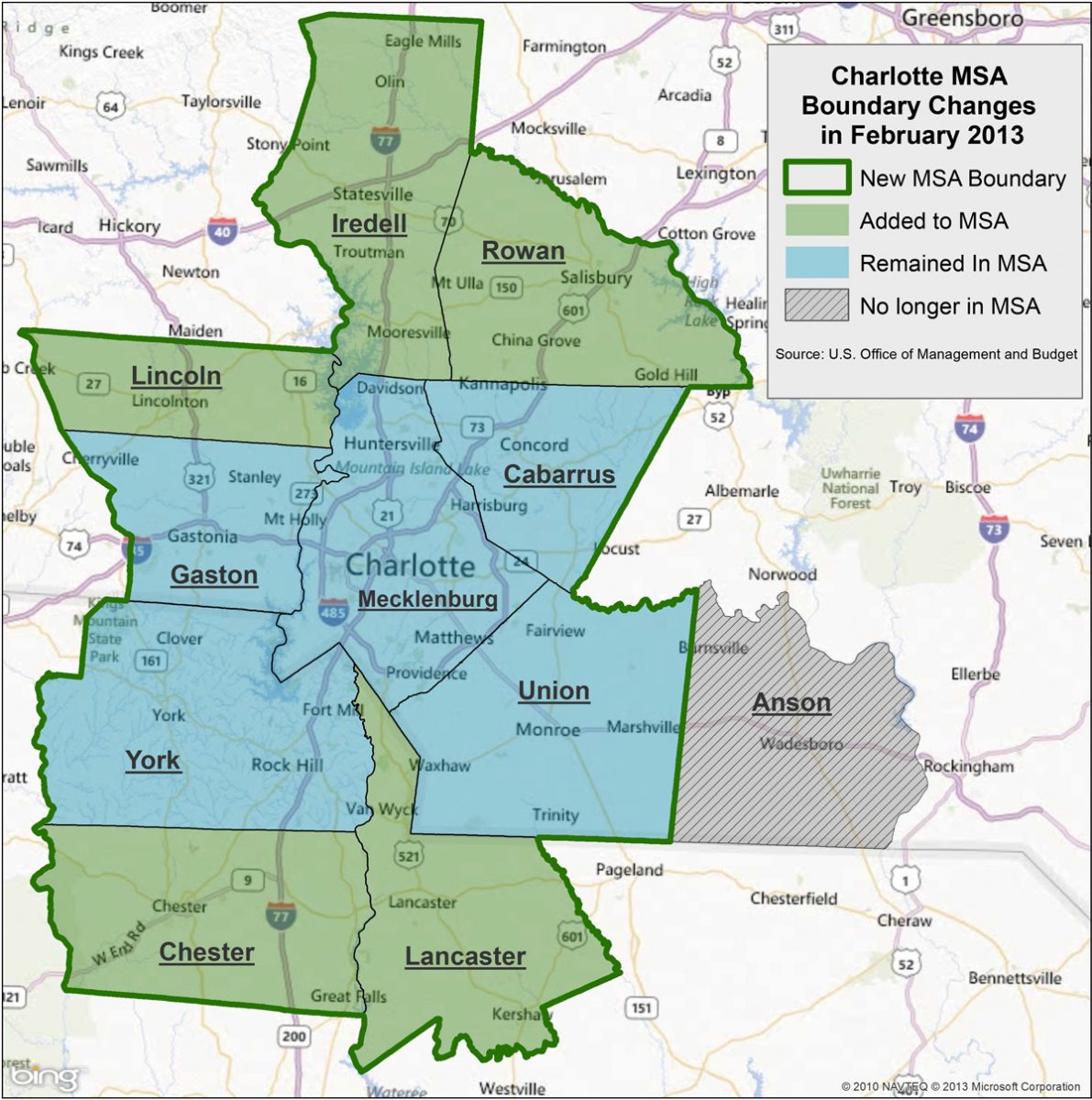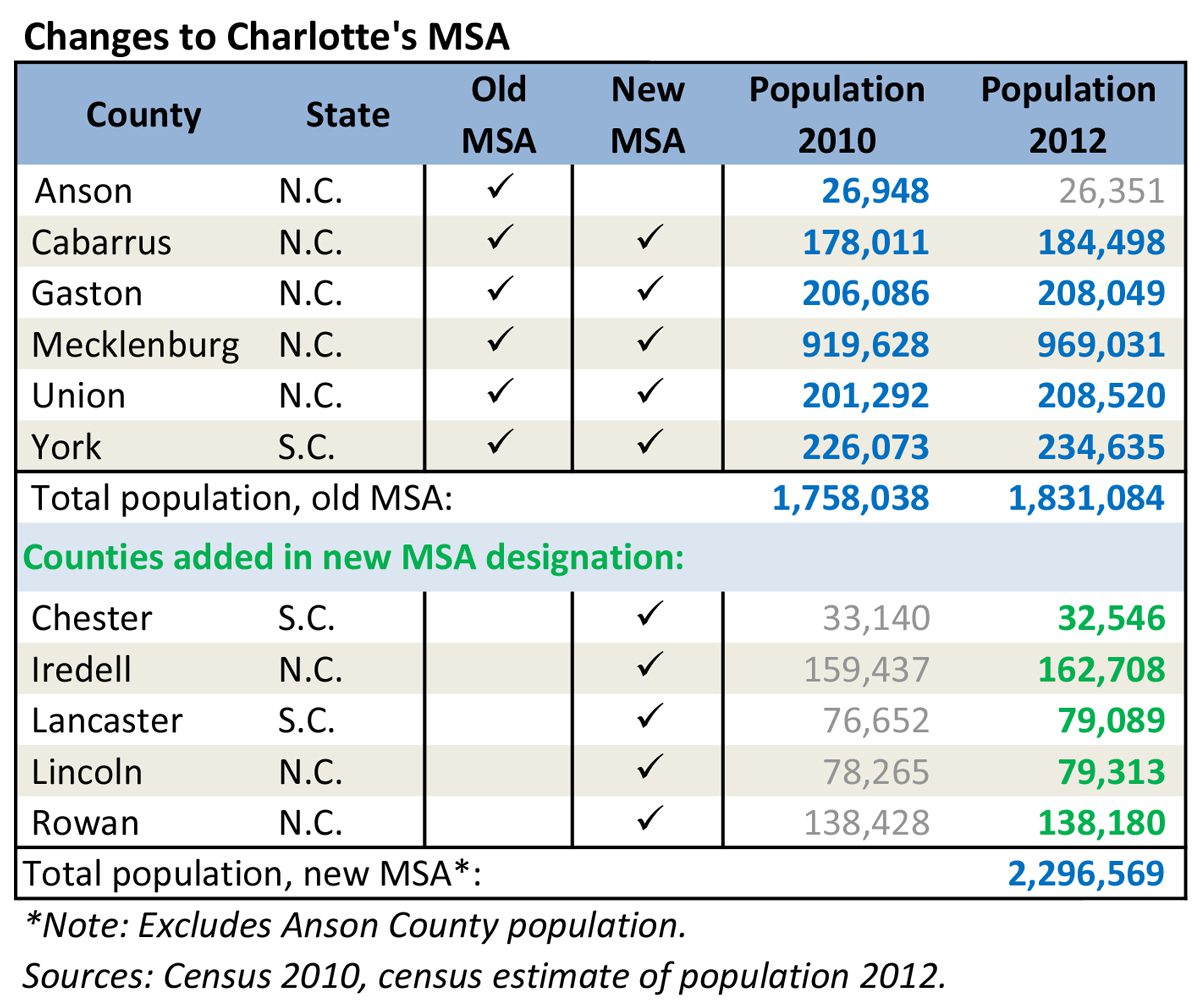Boundary change boosts Charlotte metro population

In January, the Charlotte metro area population was 1.8 million people. In February, the metro area population was 2.3 million. Where did the half-million people come from? New boundaries were drawn for metropolitan statistical areas.
In February 2013, new MSA definitions* took effect. The changes, based on commuting ties among counties, are part of an update that take place approximately three years after the 10-year census occurs (click here for details on the rules and timetable for updates). Some metro areas across the country may see little or no change, but metro Charlotte saw a net gain of four counties and more than 465,000 people.
The map below shows how the area’s definition changed this year. Five counties were added: two S.C. counties, Chester and Lancaster, and Iredell, Lincoln and Rowan in North Carolina. Anson County was dropped from the Charlotte MSA based on the new definition.

The counties added to the metro range in population from 32,000 in Chester, S.C., to more than 160,000 in Iredell. The table below lists population from several points in time for the counties that are added. Together, Iredell and Rowan account for the majority of new population in the Charlotte MSA. For a look at the national map of MSAs click here.

MSA definitions can affect the way communities are perceived, since statistics that are reported by metro area are used by a wide range of companies and other organizations. A change in counties between the Wilmington, N.C., metro and the Myrtle Beach, S.C., MSA (assigning Brunswick County, N.C., to metro Myrtle Beach) was lamented in Wilmington’s local media. Connie Majure-Rhett, CEO of the Wilmington Chamber of Commerce, said, “The thing that’s going to hurt us is we look smaller. There are chains that look at certain sizes (of locations) and you can drop off their radar.” (click here for story). For the Charlotte metro, the change is likely to be seen as generally positive, since the number of counties and size of the metro area increased, which raises the profile of the Charlotte MSA overall. Perceptions of what it means to become part of the Charlotte MSA may be mixed among the newly added counties.
The counties that are being added to the Charlotte MSA were all considered separate “micropolitan” areas before this change. A micropolitan designation refers to single counties or groups of counties that have a central core city that falls below the 50,000 population threshold required to be considered a metropolitan area (among other criteria). Anson, dropped from the Charlotte MSA, does not quality as a micropolitan area.
In some cases, losing this separate micropolitan designation can be seen as a negative. Bill McCoy, emeritus faculty at UNC Charlotte and former director of the UNC Charlotte Urban Institute, notes, “The Statesville-Mooresville micropolitan area [Iredell County] has been ranked No. 1 in Site Selection magazine for corporate facilities projects nine out of the past 11 years. By becoming part of the Charlotte MSA, Iredell will no longer be on this list, which may not change the outcomes for the area, but it will mean they will no longer benefit from the publicity associated with this ranking.”
More about Commuting
Commuting is the key factor in adjusting MSA boundaries. Read more about the latest commuting data.
Commuting between counties is the primary factor that affects the changes in metro area designations. According to the Census Bureau, 153,015 workers commuted into Mecklenburg County each day from surrounding counties in the Charlotte MSA (based on 2006-10 American Community Survey). That is among the highest number of county-to-county commuters in the U.S. The majority of those commuters travel from Union (37,442), York (29,013) and Cabarrus (28,916) counties. With two major highways, I-85 and I-77, and a central location, Charlotte’s core is accessible to many surrounding counties in the region (read more about the commuting trends here).
The Carolinas saw several other MSA changes. In addition to the Brunswick County reassignment, other changes include the emergence of new MSAs around coastal New Bern, N.C., and Hilton Head, S.C., as well as the addition of Anderson County, S.C., to the Greenville, S.C., metro.
With 10 counties, Charlotte’s MSA is the Carolinas’ largest both in population and number of counties. Officially called the Charlotte-Concord-Gastonia, N.C-S.C. MSA, it ranks 23 nationally in population, between Pittsburgh, Pa., at 22 and Portland-Vancouver-Hillsboro, Ore.-Wash., at 24.
Charlotte’s MSA expansion reflects the growing pull of Mecklenburg County (home of Charlotte) as an employment hub. The changes also reflect the historic pattern of development of cities in the region. Other large metros in North Carolina have closer cities, in adjoining MSAs . The Triangle, which at one time was the Raleigh-Durham metro, is now two separate MSAs. The three-city area that calls itself the Triad (Greensboro/Winston-Salem/High Point) is split into two MSAs, one focused on Greensboro and one on Winston-Salem.
*Note: MSA definitions are released by the United States Office of Management and Budget based on commuter and other data provided by the Census Bureau.